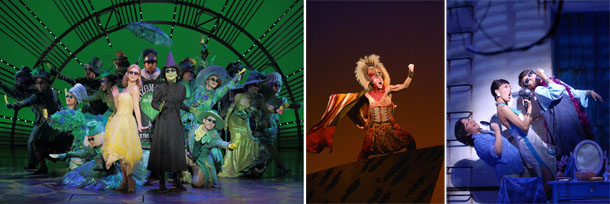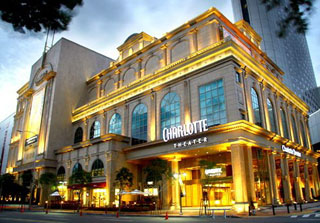Korean musicals struggle despite industry growth: Short runs common due to steady demand for new performances

From left: Highest revenue for a musical - Wicked; Longest-running musical - Lion King (1 year); Most number of runs - Mamma Mia (4 runs) [JOONGANG ILBO]
Ten years later, the establishment of the theater certainly has had ripple effects on the industry. Following its example, Blue Square, Chungmu Arts Center and the D-Cube Arts Center were constructed and remodeled to become musical-exclusive spaces as well, and the four establishments came to be known as the “Big 4” for musical entertainment. Additionally, smaller spaces seating 600-1000 audience members such as the Kwanglim Arts Center, Doosan Art Center, Hongik Art Center, Daehangno Musical Center, and others were created as well. The city of Seoul eventually became home to ten such musical-exclusive theaters.
In the past, musicals had to share space with other performance-based genres at various concert halls such as the Seoul Arts Center or Sejong Center for the Performing Arts. Because these musicals had to respect other genres and give them opportunities on stage, being able to perform long-term was impossible, which had an impact on revenues. Much of the success of musicals on New York’s Broadway or London’s West End is attributed to their number of theaters. The London-based 1986 musical “Phantom of the Opera” has been ongoing in the same theater for thirty years.
In order to observe what kind of changes that the musical-exclusive theaters brought to the domestic industry, the JoongAng Ilbo analyzed the past ten years of the “Big 4.” As of the end of this month, there have been a total of 91 productions, the majority of which were foreign musicals. A total of 78 licensed and visiting musicals on tour were shown on stage, while only 13 Korean productions were given the opportunity. In the case of the Charlotte Theater, not a single Korean musical was ever shown during its ten year history.

Charlotte Hotel [JOONGANG ILBO]
“[Musicals] have forgotten their original purpose to be long-term,” said Won Jong-won, a professor of mass communications at Soonchunhyang University.
“Lion King,” which was the first production to be performed at a musical-exclusive theater and also the longest-running (1 year), reported losses of 3.6 billion won ($3.2 million), and “Phantom of the Opera” (2009), which also came close to running for a year couldn’t become a hit either. It prompted the association of long-term productions to poor ticket sales.
“With the market being so small in the first place, the situation is worse, since Korean audiences don’t want to wait long,” said Chung Soo-yun, adjunct professor of theater and cinema at Hanyang University.
In other words, unlike musicals in other countries that have “open runs” (without a set ending date), productions in Korea would rather have multiple short runs.
Kim Yang-sun, representative director of Interpark, said, “The domestic musical industry has been showing an annual growth rate of over 10 percent every year since 2010. The musical-exclusive theaters have been largely responsible for this overall growth.” However, there have been voices of concern over the dropping revenues for individual productions. Incidentally, the real winners that have come about from the musical theaters were not musicals themselves, but classical performances such as ballets and plays who no longer had to share their stages.
In the end, the long-term trend in the industry did not change with the introduction of exclusive theaters. Adjunct professor Park said, “All that the musical theaters did during their ten year existence was not create an infrastructure, but remind us just how important that actual content is.”
It just goes to show that the musical-exclusive theaters are not the end-all solution. Professor Won said, “We need to stray away from the reliance on celebrity stardom to market the musicals, and actually focus on the production itself. We must return to our original intent.”
BY CHOI MIN-WOO [chung.jinhong@joongang.co.kr]
관객 몰린 '노트르담'도 50일…장기공연 아직 먼 얘기
2006년 10월28일, 국내 최초의 뮤지컬 전용관 ‘샤롯데씨어터’가 개관했다. 당시만 해도 전용관은 뮤지컬계 꿈의 공간이었다. 1990년대 중반 복합상영관(멀티플레스·multiplex)이 등장하면서 국내 영화 산업이 만개했듯, 뮤지컬 시장이 정상 궤도에 진입하기 위해선 전용관이 필수 인프라로 여겨졌기 때문이었다. “뮤지컬 전용관만 생기면 서울도 브로드웨이처럼 탈바꿈할 수 있다”란 호언장담이 심심치않게 나왔다.
그로부터 10년이 꼬박 흘렀다. 양적 성장은 뚜렷했다. 샤롯데씨어터를 필두로 블루스퀘어·충무아트센터·디큐브아트센터 등이 새로 건립되거나 리모델링을 해, 이른바 ‘뮤지컬 전용관 빅4’로 자리를 잡았다. 이밖에 600∼1000석 규모의 광림아트센터·두산아트센터·홍익대 대학로아트센터 ·대학로 뮤지컬센터 등 후발주자도 진용을 갖추었다. 전용관 혹은 뮤지컬 위주의 중대형 공연장이 서울에만 얼추 10여개에 이르는 상황이다.
뮤지컬 전용관이란 뮤지컬만 할 수 있는 공연장이다. 이전까지 뮤지컬은 예술의전당이나 세종문화회관 등 복합공연장 무대에 올랐다. 다른 장르와 함께 골고루 써야 하는 탓에 장기공연이 불가능했다. 수익성이 떨어진다는 얘기다. 뉴욕 브로드웨이나 런던 웨스트엔드가 뮤지컬 메카가 될 수 있었던 데엔 각각 40여개에 이르는 전용관도 빼놓을 수 없다. 1986년 런던에서 초연한 ‘오페라의 유령’은 무려 30년간 같은 극장에서 쉬지 않고 지금도 공연중이다.
그렇다면 전용관은 한국 뮤지컬 시장에 어떤 변화를 주었을까. 본지는 전용관 ‘빅4’의 지난 10년을 분석해봤다. 올 10월말까지 총 91개 작품이 공연됐다. 대다수가 해외 뮤지컬이었다. 라이선스나 내한공연이 78개인데 반해, 국내 창작 뮤지컬은 13개에 불과했다. 특히 샤롯데씨어터는 10년간 창작뮤지컬을 한편도 올리지 않았다.
작품당 공연 기간은 평균 89일. 전용관이 생기기 전과 비교해 큰 차이가 없는 수치였다. 특히 전용관에서 세 차례 공연되며 매번 흥행했던 ‘노트르담 드 파리’도 평균 공연 기간은 고작 50일이었다. 원종원 순천향대 교수는 “장기공연을 하려고 만들어졌는데 본래 목적을 상실한 꼴”이라고 평했다. 첫 전용관 작품이자 역대 최장기(1년)인 ‘라이온 킹’이 36억원의 손실을 입었고, 이후 1년 가까이 공연된 ‘오페라의 유령’(2009년)마저 히트하지 못하면서 “장기공연=흥행실패”의 공식이 생겨났다는 분석이다. 정수연 한양대 겸임교수는 “시장규모가 적은데다 오래 기다리지 않는 게 한국의 관람문화”라며 “짧게 치고 빠지는 ‘레퍼토리’가 한국만의 뮤지컬 제작방식이 됐다”고 진단했다. 해외 전용관같은 ‘오픈 런’(기한을 정해놓지 않고 공연하는 것) 대신 ‘레퍼토리화’(일정 기간 뒤에 다시 올리는 것)가 안착됐다는 설명이다.
김양선 인터파크 대표는 “2010년 이후 국내 뮤지컬 시장은 매년 10% 남짓 안정적인 성장세다. 전용관이 전체 파이를 키웠다”고 전했다. 반면 개별 작품의 수익성은 떨어진다는 하소연이 많다. HJ컬쳐 한승원 대표는 “성수기엔 약 10여개의 대형 뮤지컬이 동시에 올라간다. 관객수는 뻔한데 제작사끼리 서로 죽어라 싸우는, 전형적인 제살깎기”라고 말했다.
뮤지컬 전용관 덕에 숨통이 트이고 혜택을 본 것은 오히려 기초예술 분야다. 안호상 국립극장장은 “과거 뮤지컬은 한국 공연시장의 일종의 포획자였다”라며 “뮤지컬이 전용관으로 가게 되면서 발레·클래식·연극 등 여타 장르의 설 자리가 마련됐다”고 말했다. 개별 전용관만의 특징이 없다는 지적도 있다. 고희경 홍익대 교수는 “그저 객석수가 많고 적음에 따라 ‘전용관 서열화’ 경향이 크다”고 말했다. 현재 자체 제작을 하는 건 충무아트센터가 유일하다.
결과적으로 외국 라이선스 뮤지컬 위주로 짧게 공연하는 풍토는 전용관이 늘어났어도 달라지지 않은 셈이다. 정 겸임교수는 “한국 뮤지컬 전용관 10년은 결국 인프라가 아니라 콘텐트가 얼마나 중요한가를 새삼 확인시켜줬다”고 말했다. 전용관이 만능해결사는 아니라는 얘기다. 원 교수는 “스타 의존도를 줄이고 완성도를 높여 장기공연을 해야 한다. 초심으로 돌아가야 한다”고 꼬집었다.
최민우 기자 minwoo@joongang.co.kr










with the Korea JoongAng Daily
To write comments, please log in to one of the accounts.
Standards Board Policy (0/250자)